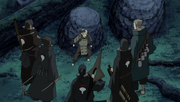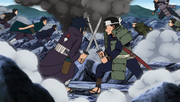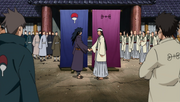Omnibender (talk | contribs) No edit summary |
Omnibender (talk | contribs) No edit summary Tag: sourceedit |
||
| (34 intermediate revisions by 10 users not shown) | |||
| Line 1: | Line 1: | ||
| + | {{Looking for|the time period|the episode|Warring States Period (episode)|Warring States Period}} |
||
| − | [[File:Clans.PNG|thumb |
+ | [[File:Clans.PNG|thumb|The many mercenary clans active during this era.]] |
| − | Before the village system was established with the founding of [[Konohagakure]] by the [[Senju]] and [[Uchiha]], the {{translation|'''Warring States Period'''|戦国時代|Sengoku Jidai}} was an extremely lengthy and bloody period in history where hundreds of individual shinobi clans fought in constant, bitter warfare. |
||
| + | The {{translation|'''Warring States Period'''|戦国時代|Sengoku Jidai}} was the long, violent era preceding the formation of the [[hidden village]]s. |
||
== History == |
== History == |
||
| − | [[File:Itama ambushed Uchiha |
+ | [[File:Itama ambushed Uchiha Clan2.png|thumb|left|A child about to die in battle.]] |
| + | During the Warring States Period, the countries of the world were uniformly small, constantly battling each other for land, power, and opportunity. To fight these battles, countries hired one or more [[clan]]s of mercenary [[shinobi]] to represent their interests, the shinobi's loyalties ultimately going to the highest bidder.<ref>Chapter 398, pages 16-17</ref> The constant warfare in turn led to constant death, creating an average lifespan of only thirty years. Children were the greatest victims of the era, forced to fight for their clan no differently than an adult would and, more often than not, being killed by older and more skilled opponents.<ref>Chapter 622, pages 12-13</ref> In an attempt to avoid conflict caused by the ever-changing alliances and resulting vendettas, shinobi were in the habit of never divulging their family names to strangers.<ref>Chapter 622, pages 4-16</ref> |
||
| − | During this era, conflicts perpetually arose between the various nations as each crusaded for more rights and land. In order to wage these wars, each individual shinobi clan rented its military might to the highest bidder.<ref>''Naruto'' chapter 398, pages 16-17</ref> Due to the unrelenting violence, the average life-span for a shinobi as well as civilians were a mere 30 years, though the single biggest reason for the continuing fall in life expectancy was the slaughter of countless conscripted children.<ref>''Naruto'' chapter 622, pages 12-13</ref> With the continued loss of their kin, a never ending cycle of death and revenge was born, which saw shinobi having to even conceal their surnames for fear of retaliation.<ref>''Naruto'' chapter 622, pages 4-16</ref> It was during this time period that Madara Uchiha and Hashirama Senju met and eventually befriended each other. Angered by the senseless slaughter of their siblings, the two began to dream of a world where peace reigned and children live full lives instead of dying prematurely on the battlefield. They also began to train with each other in hopes of achieving it. Unfortunately, this friendship was short lived as both were discovered by their respective fathers and brothers. With Madara choosing to protect his brother at all costs, the two former friends drifted apart and were forced to fight each other on the battlefield. |
||
| − | [[File: |
+ | [[File:Hashirama VS Madara.png|thumb|The Uchiha vs. the Senju.]] |
| + | Amidst all the vying for supremacy, two clans emerged as the strongest: the [[Senju clan]], famed for their balanced skill in all the shinobi arts, and the [[Uchiha clan]], famed for their [[Sharingan]]. Whenever one side in a conflict hired one of the clans, the opposing side would hire the other clan. This constant competition created a deep-seated animosity between its members, with all Senju having lost a loved one to an Uchiha and vice versa. Despite the clans' enmity, it would be the Senju and Uchiha that brought an end to the Warring States Period. [[Hashirama Senju]] and [[Madara Uchiha]] met as children, unaware of each other's identity. They quickly became friends, bonding over the deaths of their brothers, their desire to protect their remaining siblings, and their dreams of a peaceful world where children wouldn't need to fight. |
||
| − | Amongst the warring clans, only two came to be feared as the strongest: the [[Senju clan]] and the [[Uchiha clan]], who developed a deep enmity as they were often hired to oppose one another due to their rivalling strength. Eventually, both [[Hashirama Senju]] and [[Madara Uchiha]] grew to become the respective leaders of these rival clans, but despite their childhood friendship and shared dreams, the two were inevitably pitted against one another. During this time, Madara and his [[Izuna Uchiha|brother]] discovered the secret of the [[Sharingan]]; becoming the first to awaken the [[Mangekyō Sharingan]]. Though with the constant battles, Madara's vision degraded further and further until he acquired Izuna's Mangekyō Sharingan, integrated it into his own and gained the "Eternal" Mangekyō Sharingan.<ref>''Naruto'' chapter 399, pages 1-4</ref><ref>''Naruto'' chapter 624, page 14</ref> |
||
| + | Hashirama and Madara eventually learned who the other was, preventing them from continuing to meet under friendly circumstances. Over the following years, the two regularly met and fought on the battlefield, with each in time becoming the leader of his respective clan. Hashirama attempted to use their new positions to broker peace between their clans at long last, finally achieving the dreams they'd had as children. Although Madara was tempted, the death of his last remaining brother, [[Izuna]], committed him to continuing the fight. Other Uchiha, however, found the prospect of peace tempting and started surrendering to the Senju in growing numbers. With his support running out, Madara made a last stand against Hashirama and the Senju and was summarily defeated.<ref>Chapter 624</ref> From his defeat and Hashirama's willingness to give his own life to stop the bloodshed, Madara was convinced to accept the peace proposal. |
||
| ⚫ | |||
| + | |||
| − | However, after decades of conflict, most of the clans under the Uchiha and Senju banners were growing weary of the continued bloodshed. Some time before Konoha's founding and after the death of [[Izuna]], some members of the Uchiha clan began to willingly surrender, realising that they were outclassed by the Senju. The two clans were later urged to form a lasting truce by Hashirama (who still hoped to achieve his and Madara's original dream of peace). The only person who opposed this peace was Madara, who argued for the Uchiha clan to continue the fighting as he was still bitter after the death of [[Izuna]], but was ultimately persuaded to join in a permanent alliance with the Senju clan after Hashirama demonstrated his worth by nearly committing suicide in compensation. Soon after, a pact was formed with the [[Land of Fire]] and thus, [[Konohagakure]] was formed. This set a precedence which others soon followed, creating the [[Five Great Shinobi Countries]], as well as some smaller, outlying villages and settlements.<ref>''Naruto'' chapter 399, pages 4-7</ref> Realising that there must be a balance of power, Hashirama convened the first [[Kage Summit]] in order to distribute the tailed beasts he had under his control between the five major powers. However, peace wouldn't last. Some time after Konoha's founding, a disillusioned Madara would defect from the village and challenge Hashirama at the [[Valley of the End]] and was ultimately defeated. Soon afterwards, the villages began to compete with each other for resources and this competition eventually escalated into the [[First Shinobi World War]]. |
||
| ⚫ | |||
| + | The allied Senju and Uchiha formed a pact with the [[Land of Fire]] to allow them to establish a shinobi village within its borders, what would be called [[Konohagakure]]. Other clans wishing to share in the new peace settled in Konoha as well, the [[Shimura]] and [[Sarutobi clan]]s being amongst the first. Other clans in other countries, fearful of the combined might of the Senju and Uchiha, created their own villages. Thus was the Warring States Period brought to an end, replaced by the [[Shinobi Organisational System]] of the [[Five Great Shinobi Countries]].<ref>Chapter 399, pages 4-7</ref> |
||
== Influence == |
== Influence == |
||
| − | The {{translation|[[Wikipedia:Sengoku period| |
+ | The {{translation|[[Wikipedia:Sengoku period|Warring States Period]]|戦国時代|Sengoku Jidai}} was a timespan of two centuries where the Ashikaga Shogunate collapsed and Japan was torn into various factions in the midst of a bloody civil war. This moment in history was the time of many famous ninja such as [[Wikipedia:Hattori Hanzō|Hattori Hanzō]]. It was also an era where shinobi were in high demand for unconventional tactics such as infiltration, espionage, assassination, and sabotage. But after the war resolved in 1615 with the establishment of the Tokugawa Shogunate, their services were cut in a united Japan and ninja began to fade into history. |
| + | |||
| + | The [[Wikipedia:Warring States Period|Warring States Period]] (simplified Chinese: 战国时代; traditional Chinese: 戰國時代; pinyin: Zhànguó Shídài) was also timespan of three centuries in Chinese History where the Zhou Dynasty was extinguished and the Chinese Empire split in to various warring city-states. It followed the Spring and Autumn period and concluded with the victory of the state of Qin in 221 BC; creating a unified China under the Qin Dynasty. |
||
== References == |
== References == |
||
| − | <references/> |
+ | <references /> |
[[Category:Battles]] |
[[Category:Battles]] |
||
Revision as of 17:51, 27 December 2015
| This article is about the time period. For the episode, see Warring States Period. |

The many mercenary clans active during this era.
The Warring States Period (戦国時代, Sengoku Jidai) was the long, violent era preceding the formation of the hidden villages.
History

A child about to die in battle.
During the Warring States Period, the countries of the world were uniformly small, constantly battling each other for land, power, and opportunity. To fight these battles, countries hired one or more clans of mercenary shinobi to represent their interests, the shinobi's loyalties ultimately going to the highest bidder.[1] The constant warfare in turn led to constant death, creating an average lifespan of only thirty years. Children were the greatest victims of the era, forced to fight for their clan no differently than an adult would and, more often than not, being killed by older and more skilled opponents.[2] In an attempt to avoid conflict caused by the ever-changing alliances and resulting vendettas, shinobi were in the habit of never divulging their family names to strangers.[3]

The Uchiha vs. the Senju.
Amidst all the vying for supremacy, two clans emerged as the strongest: the Senju clan, famed for their balanced skill in all the shinobi arts, and the Uchiha clan, famed for their Sharingan. Whenever one side in a conflict hired one of the clans, the opposing side would hire the other clan. This constant competition created a deep-seated animosity between its members, with all Senju having lost a loved one to an Uchiha and vice versa. Despite the clans' enmity, it would be the Senju and Uchiha that brought an end to the Warring States Period. Hashirama Senju and Madara Uchiha met as children, unaware of each other's identity. They quickly became friends, bonding over the deaths of their brothers, their desire to protect their remaining siblings, and their dreams of a peaceful world where children wouldn't need to fight.
Hashirama and Madara eventually learned who the other was, preventing them from continuing to meet under friendly circumstances. Over the following years, the two regularly met and fought on the battlefield, with each in time becoming the leader of his respective clan. Hashirama attempted to use their new positions to broker peace between their clans at long last, finally achieving the dreams they'd had as children. Although Madara was tempted, the death of his last remaining brother, Izuna, committed him to continuing the fight. Other Uchiha, however, found the prospect of peace tempting and started surrendering to the Senju in growing numbers. With his support running out, Madara made a last stand against Hashirama and the Senju and was summarily defeated.[4] From his defeat and Hashirama's willingness to give his own life to stop the bloodshed, Madara was convinced to accept the peace proposal.

The Senju and Uchiha form an alliance.
The allied Senju and Uchiha formed a pact with the Land of Fire to allow them to establish a shinobi village within its borders, what would be called Konohagakure. Other clans wishing to share in the new peace settled in Konoha as well, the Shimura and Sarutobi clans being amongst the first. Other clans in other countries, fearful of the combined might of the Senju and Uchiha, created their own villages. Thus was the Warring States Period brought to an end, replaced by the Shinobi Organisational System of the Five Great Shinobi Countries.[5]
Influence
The Warring States Period (戦国時代, Sengoku Jidai) was a timespan of two centuries where the Ashikaga Shogunate collapsed and Japan was torn into various factions in the midst of a bloody civil war. This moment in history was the time of many famous ninja such as Hattori Hanzō. It was also an era where shinobi were in high demand for unconventional tactics such as infiltration, espionage, assassination, and sabotage. But after the war resolved in 1615 with the establishment of the Tokugawa Shogunate, their services were cut in a united Japan and ninja began to fade into history.
The Warring States Period (simplified Chinese: 战国时代; traditional Chinese: 戰國時代; pinyin: Zhànguó Shídài) was also timespan of three centuries in Chinese History where the Zhou Dynasty was extinguished and the Chinese Empire split in to various warring city-states. It followed the Spring and Autumn period and concluded with the victory of the state of Qin in 221 BC; creating a unified China under the Qin Dynasty.
